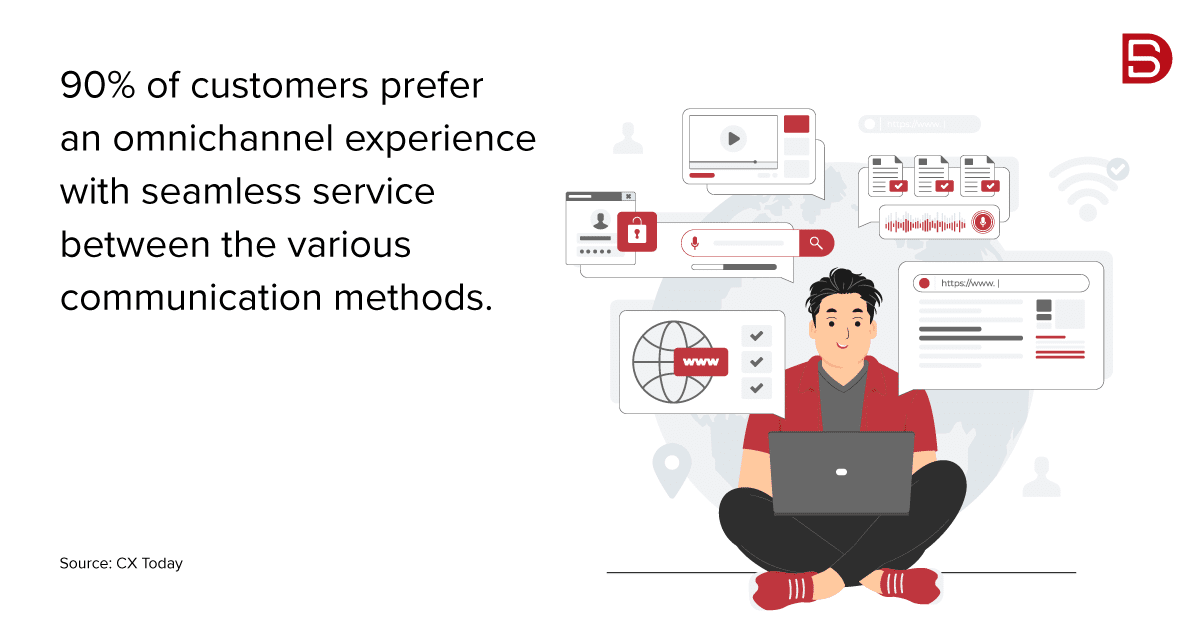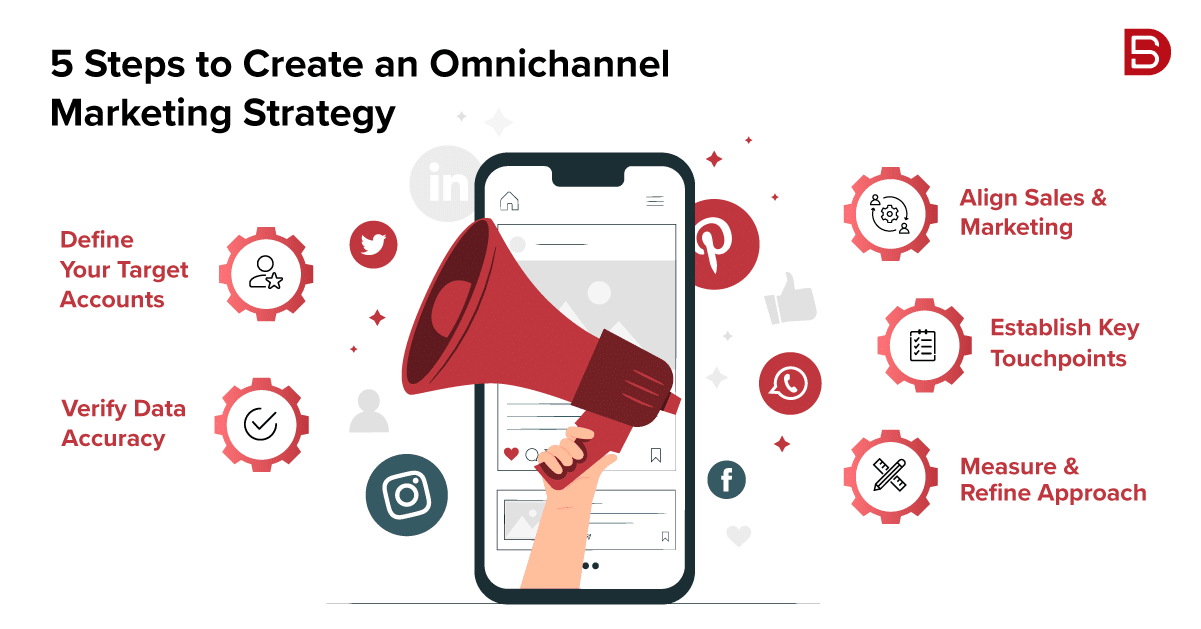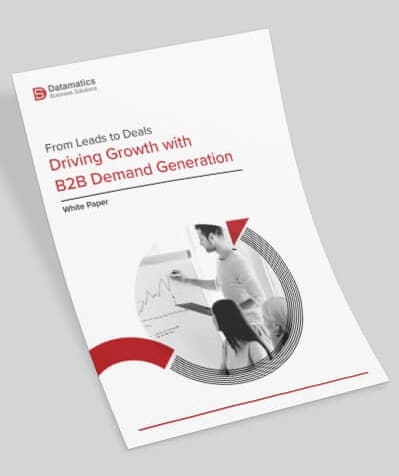Ever noticed how the seamless buying experiences in your personal life set the bar for what you expect at work? It’s no different for your B2B customers. They crave the same smooth interactions, and while you don’t need to be as big as Amazon, embracing an omnichannel marketing approach can make all the difference.
This means meeting your customers where they are, offering helpful information wherever they look for it. In this blog, we walk you through the importance of omnichannel marketing along with strategies to make it easier for clients to engage with you on all fronts.
Bridging Channels: The Power of Omnichannel Marketing in B2B
B2B omnichannel marketing involves the seamless coordination of all your sales, marketing, and customer success channels to create a dependable brand experience for prospective and existing accounts. This client-centric approach involves integrating multiple platforms to ensure a smooth and fluid journey with your company.
The main objective is to deliver relevant information and offerings where your target accounts expect to find them, whether through email, social media, retargeted ads, or other methods. An omnichannel approach ensures a positive encounter on every channel by maintaining consistent branding, personalized messaging, and tailored content based on the buyer’s stage in the journey.
Driving B2B Growth with Omnichannel Marketing
Marketing aims to drive sales, and revenue teams are keen on knowing the ROI for every resource your organization invests in tactics. With an omnichannel marketing approach, B2B sales pros and marketers can easily prove the value of their efforts by connecting all channels in one platform, providing a clear picture of results. Plus, this setup allows go-to-market (GTM) teams to quickly spot what’s working and what’s not, making it easier to adapt strategies on the fly.
Modern customers have evolved beyond the days of simple cold calling. Sales and marketing teams must understand that each platform a prospect interacts with is an opportunity for genuine engagement.
Steps to Create a Winning B2B Omnichannel Marketing Strategy
Your customers sure want it, and the perks are crystal clear. But if you’re starting with a blank slate, how do you go about crafting a B2B omnichannel marketing strategy? Here’s a detailed breakdown to guide you through the process:
1. Define Your Target Accounts
Getting your omnichannel marketing strategy off the ground isn’t just about starting; it’s about starting smart. To kick things off smoothly, first, identify the existing accounts you want to focus on.
Your sales and marketing teams might have different goals, so what makes an account worth targeting can vary. It could be their company size, the technology they’re using, or where they are in their buying journey. By zeroing in on these critical factors to create your Target Accounts List (TAL), you’ll set yourself up for success. Prioritize the accounts with the most potential to boost your omnichannel marketing efforts now and in the future.
This step is also a perfect opportunity to segment your Total Addressable Market (TAM). B2B market segmentation means finding similarities among accounts and grouping them accordingly. This approach informs how you’ll engage with different segments and identifies the ones that align best with your offering.
For an extra boost, revisiting your buyer personas can ensure your messaging hits the mark. In B2B marketing, it’s crucial to remember that there’s a real person at the end of your GTM efforts. So, keeping their needs and situations top of mind is key.
2. Verify Data Accuracy
Your omnichannel marketing efforts are only as good as the data they rely on. Poor data quality can wreck your plans, but clean data can take your strategy to new heights. That’s why it’s crucial to keep a close eye on the quality of your data.
Here are some questions to consider:
- Is your data up to date? Trends change fast, so stale information won’t cut it.
- Are there any gaps in your accounts’ contact details? Incomplete or inaccurate data can hurt your campaign performance.
- Do you have duplicate entries in your CRM? Not only does this create headaches for your sales team, but it also wastes marketing resources and risks annoying your prospects or customers.
By carefully cleaning and managing your CRM data, filling in missing details, double-checking account information, and removing duplicates, you’ll lay the groundwork for a successful omnichannel marketing strategy.
3. Align Sales & Marketing
To craft a winning B2B omnichannel marketing plan, it’s crucial to get your sales and marketing teams on the same page. They shouldn’t just work together; they need to be totally in sync and striving for the same goals.
By joining forces, they can target the right accounts effectively, narrowing down from the overall market to the ideal customer profile and selecting the most relevant businesses for specific campaigns based on where they are in their journey and their intent signals. This collaboration results in a powerful marketing strategy that delivers a personalized experience for potential customers.
4. Establish Key Touchpoints
When mapping out your GTM strategy, pinpoint the key moments where customers connect with your brand, tailored to each customer group and their journey stage. Here are some important touchpoints and smart ways to leverage them in your marketing strategy:
- Website Visits: Your website is often the first stop for potential customers. It’s not just about impressing them; it’s about turning those visits into real opportunities. Depending on your industry, you could offer valuable resources like white papers or eBooks or make it simple for them to request an online quote.
- Connecting with Customers: While digital tools are essential, the human touch of great sales support remains key. Sales teams can shine by adapting their approach to customer interactions based on how they engage across different channels.
- Building Relationships: Managing accounts is about more than just picking up the phone. It’s about creating meaningful connections through personalized emails, engaging social media content, and relevant ads that resonate with customers.
- Segmentation is key here, too. By understanding and grouping accounts based on their interests and behaviors, you can tailor your messaging to each group, making it more personal and practical.
 Select an element to maximize. Press ESC to cancel.
Select an element to maximize. Press ESC to cancel.5. Measure & Refine Your Strategy
To keep your omnichannel marketing efforts on track, try to regularly measure, test, and tweak your strategies. This means figuring out the key metrics for each channel and linking them to specific stages in the customer journey:
- Qualified: These are potential customers who fit your ideal profile but might not be familiar with your brand yet.
- Aware: These customers know about your brand but haven’t fully engaged with it.
- Engaged: They’re interacting with your brand but have not shown real interest in buying.
- Marketing Qualified Lead (MQL): They’re showing signs of interest in your offer.
- Sales Qualified Lead (SQL): They’re almost ready to make a purchase, and you’ve got their attention.
- Customer: They’ve made a purchase – congrats!
- Post-sale: Now, it’s time to look for opportunities to upsell or cross-sell to existing customers.
By keeping an eye on these stages and adjusting your approach as needed, you can make sure your omnichannel strategy is working as effectively as possible.
Whether you’re keeping tabs on web forms filled out during the “Qualified” stage or noting repeat orders post-sale, staying in tune with each KPI keeps your B2B omnichannel marketing efforts healthy. Also, let’s not forget that solid data integrity is the backbone of omnichannel marketing. Keep fine-tuning and assessing the data quality that drives your marketing endeavors.
Make the Most of Every Marketing Channel
Anything with “Omni” in front might sound big and overwhelming, but B2B omnichannel marketing is doable. It’s not just for consumer-focused businesses; it can totally transform B2B sales and marketing. It ensures you stay relevant to your customers wherever and whenever they need you.
Finding it challenging to generate leads on your own? Consider partnering with lead generation outsourcing companies. Drop us a line at marketing@datamaticsbpm.com to learn how we can assist you in driving more leads and growing your business. Let’s team up to unlock new opportunities!
 Select an element to maximize. Press ESC to cancel.
Select an element to maximize. Press ESC to cancel.
Paul van de Kamp




